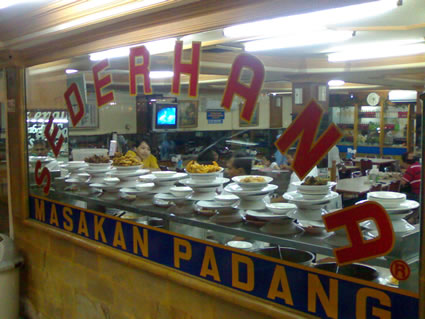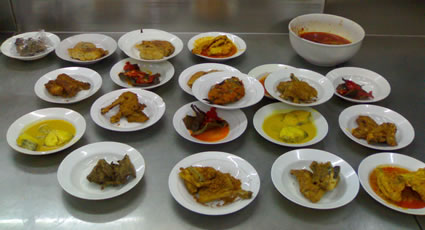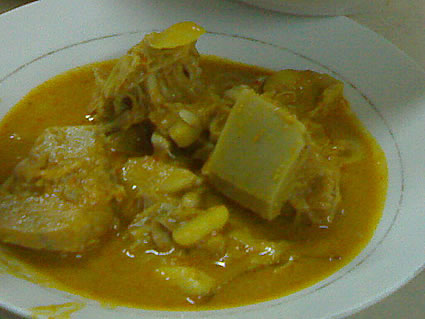A Taste of the Spice Islands
Culinary Adventures in Indonesia
Article and Photos by Wayne Johnson

Padang restaurants are all over Jakarta.
|
As you might expect from a nation of over 17,000 islands, Indonesia is a food lover’s paradise. However, it remains a relatively undiscovered region which forever lives under the gourmet shadow of its northern rivals: Malaysia, Thailand, and Vietnam. Most people — if they have any notion of Indonesian cuisine at all — may associate it with nasi goring (fried rice) or satay (meat cooked and presented on skewers with peanut sauce), but despite the fact that both of these dishes can be delicious, it does a great disservice to an archipelago containing hundreds of different cultures and a wide range of flora and fauna. There has also been a long history of immigration and integration, so Chinese cooking and influences are very strong — as to a lesser extent are Indian and Arabic flavors. However, these influences and styles vary greatly across a country which stretches more than 2800 miles from Medan in Sumatra to Jayapura in Papua. For those who truly want a gastronomic tour with a difference, there can be few things more adventurous and intriguing than traveling through Indonesia’s regions and sampling the different local culinary specialties.
In the following sections I will attempt to highlight some of the specialties you can find on the major islands traveling from west to east, but culinary tour is this is by no means exhaustive; really intrepid travelers out there are free to sample things like fried rat and fruit bat in northern Sulawesi or beetle grubs in Papua if they are so inclined. Beware though, since much of Indonesia is infrequently visited by tourists — outside of the malls and hotels — many restaurants may have cleanliness standards which fall way below western ideals. Like anywhere, use your common sense and check how popular and clean the place looks before you partake of the food if you lack an iron clad stomach or have not built up bacterial resistance by living here for a while.
Eating in Sumatra
One of the most popular and also uniquely Indonesian styles of food is one which originates from Padang in Sumatra. However, it has spread from its original base, and you will see Padang restaurants everywhere in Indonesia from the biggest cities to the smallest towns. They are a must try if you are visiting the country. Padang restaurants are unmistakable with their window display showing plates of already cooked dishes piled high in an elaborate pyramid formation. In these restaurants you will be expected to eat with your right hand, with a bowl of water being provided for cleaning your fingers. However, if like me you are a slobbering baboon without utensils, then a spoon and fork will always be provided if you ask. When you sit down the waiter will bring a huge array of dishes to your table, spread them out in front of you, and leave them there until you have finished your meal. You only pay for what you eat but you will be charged if you only take a nibble at one of the dishes. However, the cost, like most things in Indonesia, is minimal and you may want to try a bit of everything. Famous Padang dishes to look out for include Beef Rendang (beef slowly cooked in spices and coconut milk), Pop Ayam (chicken breast without the skin and served with tomato paste), and yellow curry chicken and egg balado (boiled egg with spicy chili paste.) There will also be a large amount of vegetable plates and other dishes perhaps less palatable for the western palette, such as deep fried lungs and grilled intestines. For a truly unique flavor of Indonesia a visit to a Padang restaurant is a must.

Padang dishes in a restaurant.
|
Eating in Java
Java is the most populous island in Indonesia, with some 120 million people cramming into its shores. And while it is not the biggest island geographically, it is certainly one of the most culinary diverse. The capital Jakarta has recently begun to get serious about its food, and new restaurants are sprouting up constantly — with many of them attracting international chefs and winning awards. There is also a heavy Chinese influence to the cooking here due to the large Chinese population and also the length of time they have been living in the capital. A classic dish to try in Jakarta is Bubur Ayam (a kind of porridge with chicken and vegetables mixed together with a chili sauce) and Gado Gado, (a salad of tofu, green beans, lettuce and bean sprouts and crackers smothered with peanut sauce.) Due to the belief amongst the population in the rest of Indonesia that Jakarta’s streets are paved with gold, it is a magnet for migrants from across the country. This means that if you really have a limited time then you could feasibly sample all the different Javanese and Indonesian cuisines without leaving the capital. But this is not as much fun as traveling through this fascinating island.
An area in Java which prides itself on having its own language and culture is that of Sunda in West Java. Its major city, Bandung, is only two hours from Jakarta and used to be called the Paris of the East during Dutch colonial times. Bandung is famous for its cheap factory outlets where brands like Nike, Adidas, and premium brands can be bought at ridiculously cheap prices. It is also justifiably famous for its Sundanese food. Thousands of Jakartans converge there every weekend for eating and shopping. A typical Sundanese restaurant will have a self-service counter piled with copious amounts of raw and cooked vegetables such as lettuce, cucumber, and kangkung (a kind of wild spinach) — with other foods including tempe (made from fried soya beans), fried chicken, spicy grilled fish, fried prawns and Sayur Asem (a sweet and spicy soup with potatoes, beans and corn) all accompanied by a bowl of sweet but fiery chili based sambal (sauce) and washed down with sweetened black tea. For those with a sweeter tooth then your next stop should be the old imperial capital of Yogyakarta. This is home to the spectacular world heritage sites of the Buddhist temple of Borobudur and the Hindu complex of Prambanan, both over 1,000 years old. It is also home to the unusual Gudeg (Jackfruit curry). The Jackfruit is a huge fruit with yellow flesh which has an unusual sweet taste which in this region is cut into large chunks and mixed with vegetables to make a slightly watery and not too spicy curry. Continuing east we come to Surabaya, the second largest city in Java with a population of nearly three million. It too has a large Chinese population and dishes recommended to try here include mie goring seafood (seafood fried noodles) and goring mentega (chicken cooked with butter and onions).

Jackfruit curry.
|
Eating in Bali
The one place in Indonesia almost everyone has heard of is Bali and it is justifiably famous for its stunning beaches, lush countryside and vibrant culture. It is also home to some interesting food, with your best chance to find authentic Balinese cooking being outside of the package tour destinations of Kuta and Nusa Dua. The cultural center of Bali is Ubud and is a good place to try Balinese food. After making your way across Sumatra and Java one of the big differences in Balinese cuisine you will notice compared to that of its larger Javanese neighbor is that pork is a popular part of the diet. Due to the fact that these two islands have a predominantly Muslim population it is an uncommon meat outside of ethnic restaurants or areas where the majority of the population is non-Muslim such as Lake Toba in Sumatra. A particular favorite pork dish in Bali is Babi Guling (roast suckling pig). At some of the restaurants in the tourist areas you will have to order it 24 hours in advance but in Ubud and non-touristy towns there will be restaurants specializing in this dish. The only thing that may put some people off of what is a very tasty meat is the fact that they roast a piglet rather than a fully grown pig and the carcass will sometimes be set on prominent display next to the carved meat and skin. A great place to try roast pork and great Martini cocktails to accompany it is Naughty Nuri’s restaurant in Ubud.
Eating in Maluku
Continuing our journey eastwards across the archipelago we come to the fabled spice islands of Maluku province. Until the 19th century these islands were the only places in the world where nutmeg grew, and they were also home to other spices such as cloves and pepper. It was nutmeg, a spice worth more than its weight in gold in medieval times, which first brought the Dutch to Indonesia to establish a monopoly on the trade, and it was nutmeg which forced them to trade the then poor backwater of Manhattan Island with the British for the tiny nutmeg-growing Run Island in Maluku. So, where better to try a dish made with nutmeg than in its original home? However, this is not as easy as it seems, because despite originating from Indonesia the populace don’t really use it that much in cooking. There are nutmeg (palu) dishes you can try in Maluku though, particularly in Ambon or the tiny Banda Islands such as fried fish covered in nutmeg paste or bread with nutmeg jam.
Eating on the Other Islands
Obviously with Indonesia being such a huge country and consisting of approximately 17,000 islands, it is impossible in an article to write about all the different foods to be enjoyed. I have just tried to give you a taste of regional offerings in some of the more well known regions. However, among other highlights on offer outside of the above destinations is spicy Manado chicken in northern Sulawesi, Pisang Goreng Kalimantan (fried sweet banana from Borneo), and deep fried cassava from Papua. Wherever you go, one thing for certain — your taste buds will not be disappointed!
|
Sample Indonesian Recipes
Chicken Satay
Ingredients:
400 g chicken, cut into 1 X 2 cm pieces
2 tablespoons sweet soy sauce
1 tablespoon margarine, melted
Tomato, sliced
Shallots, sliced
Peanut Sauce
100 g peanuts, roasted, skinned, fried, ground
2 red chilies, ground
5 bird's eye chilies, ground
50 cc wweet soy sauce
3 shallots, finely sliced
1 tablespoon lime juice
Combine all the ingredients for peanut sauce. Serve as a dip for the satay.
Method
-
Thread 4-5 pieces chicken onto satay skewers.
-
Mix sweet soy sauce and melted margarine.
-
Dip each skewer in this sauce until the meat is completely covered.
-
Grill until golden brown, turning skewers over from time to time.
-
Serve with peanut sauce, tomato and shallots.
***
Beef Rendang
Ingredients:
1 1/4 liters coconut milk from 2 old coconuts
1 turmeric leaf, torn and knotted
5 kaffir lime leaves
1 stalk Lemon grass, bruised
1-2 pieces Asam Gelugur (if available)
10 red chilies, finely sliced
1 kg beef, fat and sinew removed, cut into 3 cm cubes
Spices (ground)
3 tablespoons chopped galangal
1/2 tablespoon chopped turmeric
1/2 tablespoon chopped ginger
200 g red chilies
4 shallots
Pinch salt
Method
-
Simmer coconut milk with turmeric leaf, kaffir lime leaves, lemon grass, asam gelugur, sliced chilies and ground spices until the milk thickens and becomes oily.
-
Reduce heat.
-
Add beef and cook until tender.
-
Stir occasionally until the spices dry and turn brown.
|
Wayne Johnson comes from a town in the north of England and, after graduating from University, moved into a career in journalism. After experiencing the bright lights of London for eight years and working on various magazines and websites, he decided to travel across Asia. He resides in Indonesia, where he works as a freelance journalist and teacher and travels when he is not working.
|
